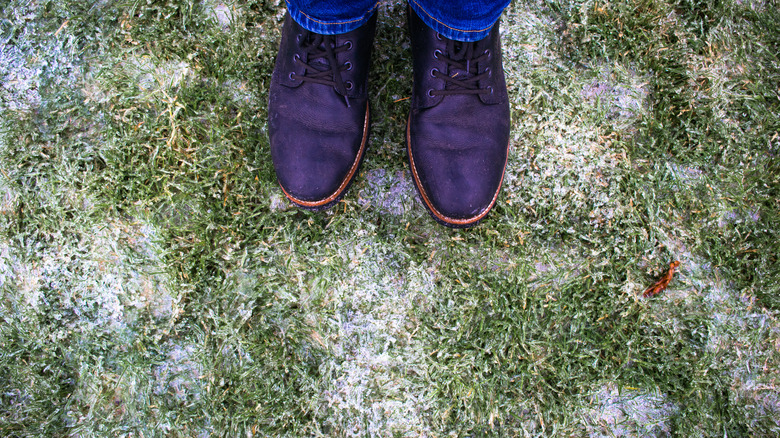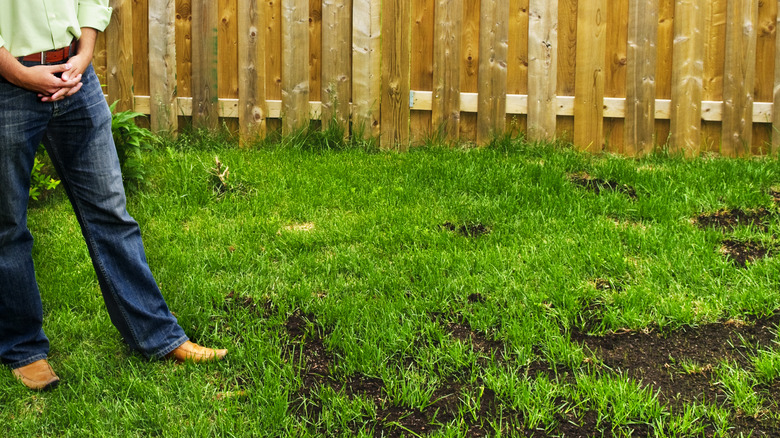One of the biggest transitions from renting to home ownership is taking on the new responsibility of yard work. At first glance, this might not seem like such a difficult task, but many new homeowners seem to struggle with it. Even if you don’t have landscaping duties, a vegetable garden, or even flower beds, just maintaining a neatly manicured lawn throughout the year can be a struggle. In an exclusive interview, House Digest spoke with lawn care expert and president of Lawn Squad lawn care company, Rob Palmer, about the biggest mistakes homeowners make with their yards in the winter. His answer? Over-raking all those fallen leaves. “As a general rule of thumb,” Palmer states, “we discourage homeowners from raking their lawn throughout the winter to avoid any damage to the leaf tissue of their grass.”
There’s been a growing movement to stop bagging up all the leaves off your lawn because the decomposing leaves actually provide a natural habitat for tons of tiny wildlife as well as invaluable nutrients for the soil. When we bag up our leaves, not only does it deny our yards this ecological boon, but a 2024 EPA study said that 7.2% of bagged yard waste winds up in landfills, contributing to greenhouse gasses. And it turns out, all that raking also damages your grass during its delicate dormant period, when “the leaf tissue is softer and more prone [to] damage,” Palmer said.
How raking during winter damages grass

Speaking exclusively with House Digest, Rob Palmer explained, “The biggest mistake we see homeowners make during the winter season is raking their lawn too aggressively in an attempt to restore grass matted down from excess moisture.” Essentially, when homeowners rake up leaves, the grass underneath is wet and tamped down. This also happens following a snowfall that has subsequently melted. Homeowners sometimes use their rakes to lift up the grass, but Palmer says this is a bad idea because it damages the grass tissue, fragile in its dormant state. The presence of ice can also make your grass more prone to damage, by tearing at it with its sharp edges. “Once that damage occurs,” Palmer said, “it will exist until the grass comes out of dormancy and hamper the lawn’s growth as it makes its transition out of inactivity.”
“Even if the damage is minor,” he continued, “your lawn is using all of its resources for root development and overall health during the dormant period.” This could lead to bare patches and other inhibited growth once the seasons change, which may require that you hire a professional. Best to take care of your lawn in early autumn, prepping it for winter and then leaving it undisturbed during snowy months. In the case of extreme matting, Palmer says “We recommend using a blower instead of a rake because that will help lift the grass and fluff it up without the damage.”
What to do if your lawn is damaged

If come spring, your lawn is showing signs of bare spots or other damage, Rob Palmer exclusively tells House Digest that you should seek out a professional consultation. “Healthy lawns coming out of winter dormancy will experience a significant growth surge,” he states, “so identifying areas that may not be growing, and providing solutions to encourage that growth, is very easy in the [spring].”
Bare spots may be caused by rake damage to the grass in winter, but other things can cause them too, such as fungal diseases and inhospitable soil. It could even be a grub infestation, though just coming out of winter this is less likely. Given the wide range of possibilities, however, seeking expert advice is the best course of action so the right corrections can be made to ensure a full and healthy lawn for the future. Of course, the cost of lawn care varies widely depending on the type of service you’re looking for, the size of your lawn, your geographic location, and other factors, but the national average cost for lawn service ranges from $48-$206, which might be well worth saving yourself the headache of trying to figure out the problem yourself.
